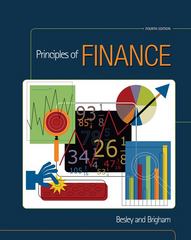Question
1. A zero coupon bond with 2.5 years to maturity has a yield to maturity of 25% per annum. A 3-year maturity annual-pay coupon bond
1. A zero coupon bond with 2.5 years to maturity has a yield to maturity of 25% per annum. A 3-year maturity annual-pay coupon bond has a face value of $1000 and a 25% coupon rate.
The coupon bond also has a yield to maturity of 25%. Does the longer maturity bond have a larger interest rate sensitivity? Why or why not? Calculate for each bond the percentage price change associated with a change of yield to maturity from 25% to 26%.
2. Construct profit diagrams or profit tables on expiration to show what position in IBM puts, calls and/or underlying stock best expresses the investor?s objectives described below. Assume IBM currently sells for $150 so that profit diagrams/ tables between $100 and $200 (in $10 increments) are appropriate. Also assume that ?at the money? puts and calls cost $15
each. (As usual, the profit calculations ignore dividends and interest.)
(a) An investor wants upside potential if IBM increases but wants (net) losses no greater than $15 if prices decline.
(b) An investor wants to capture profits if IBM declines in price but wants a guaranteed limited loss if prices increase.
(c) An investor wants to capture profits if IBM declines in price and is ready to accept unlimited losses if prices increase. Further, the investor wants to break even if the stock
price does not change between now and the maturity of the options.
(d) An investor wants to profit if IBM?s upcoming earnings announcement is either unexpectedly good or disappointingly bad.
3. Suppose today?s stock price of Book.com is $100. With probability 60% the price will rise to
$130 in one year and with probability 40% it will fall to $80 in one year. A European put
option with a strike price of $90 and a time to expiration of one year sells at $4.
(a) What is the one-year risk free rate implied by no-arbitrage (hint draw a binomial tree)?
(b) What would be the no-arbitrage risk free rate if with a probability of 50% the price increases and with a probability of 50% it decreases, keeping all other values constant? Explain.
4. (See the attached file) We want to explore the effect of changing the time to expiration T from 1 to 2 years on the value of an out-of-the-money put option. Throughout this exercise we keep the stock price at S=70, the strike price at X=40, the dividend rate at r=0, and the stock price volatility at?=35%. For the interest rate r, consider various Values.
(a) Show how the effect on the put price for T = 1 ---> 2 depends on the interest rate and explain intuitively why this happens.
(b) Confirm that the call price is always increasing in the time to expiration T.

Step by Step Solution
There are 3 Steps involved in it
Step: 1

Get Instant Access to Expert-Tailored Solutions
See step-by-step solutions with expert insights and AI powered tools for academic success
Step: 2

Step: 3

Ace Your Homework with AI
Get the answers you need in no time with our AI-driven, step-by-step assistance
Get Started


